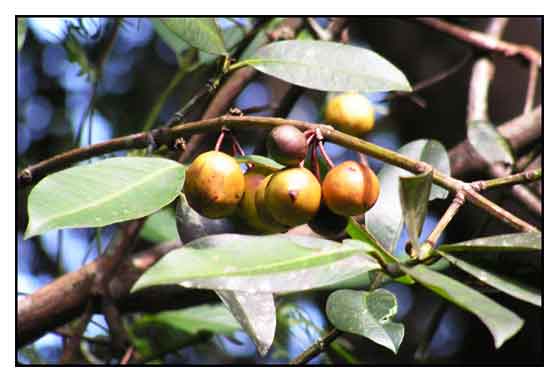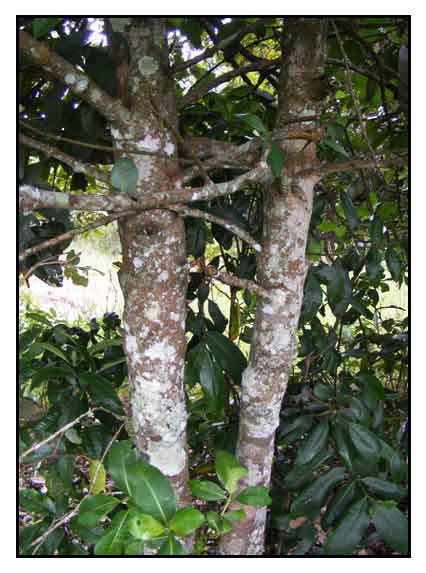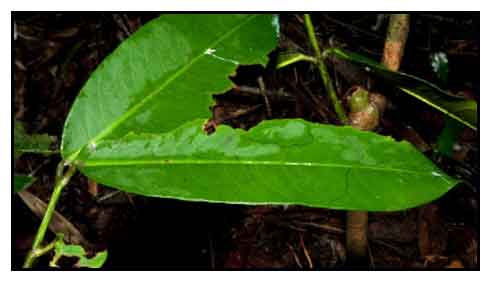 Botany Botany
Garcinia smeathmanii is a hairless evergreen shrub or tree growing up to 15- 25 meters high, erect, much branched. Bole is straight, 2o centimeters or more in diameter. Branches are longitudinally grooved. Leaves are opposite; stipules are absent. Flowers are in fascicles of 5 to 30 in the leaf axils. Fruit is a globose berry, yellow when ripe, 1 to 2.5 centimeters.
Distribution
- Introduced.
- Widespread in tropical Africa.
Constituents
- Study of methanolic extract of stem bark yielded 10 compounds: Cheffouxanthone (1). 1,5-dihydroxy-xanthone (2), 1,3,5-trihydroxyxanthone (3), bagangxanthone A (4), Smeathxnthone B (5), Smeathxanthone A (6), Guttiferone 1 benzophenone) (7), Isoxanthochymol (8), triterpene (Friedelin) (9), and cinnamate (Triacontanyl caffeate) (10). (see study below) (3)
- Study of stem bark yielded a
new prenylated xanthone, 1,3,5,8-tetrahydroxy-2-(3-methyllbut-2-enyl)-4-(3,7-dimethylocta-2,6-dienyl) xanthone (1) and a new benzophenone (2), along with four known xanthone derivatives, cheffourxanthone (3), smeathxanthone A (4), smeathxanthone B (5), anani-xanthone (6),and two pentacyclic triterpenes, epi-friedelinol (7) and friedelin (8). (see study below) (9)
- Study of roots isolated eight compounds. two were xanthone garciniaxanthone 1 (1) and the triterpene, garcinane (2), along with three known xanthones, smeath-xanthone A (3), smeathxanthone B (4), and chefouxanthone (5), one benzophenone, isoxantho-chymol (6), one triterpene, magnificol (7), and one sterol, ß-sitosterol. (see study below) (10)
 Properties Properties
- Studies have suggested antibacterial, antifungal, wound healing, antioxidant, antidiabetic properties.
Parts used
Bark, latex.
Uses
Edibility
- Fruit is edible, eaten in times of scarcity. (2)
Folkloric
- No reported folkloric medicinal use in the Philippines.
-
Bark yielded a bright yellow latex used for wound dressing. (2)
- Latex used for treating ophthalmia. (2)
- Bark decoction used as purgative, treatment of female sterility, and as antidote for poisoning. (2)
- In Africa, stem bark used for treatment of HIV.
(6)
Others
- Wood: Hard and durable; use for post construction in Ghana. (2)
- Tooth cleaner: Chewed to clean the teeth.
Studies
• Antibacterial / Antifungal / Stem Bark: Study evaluated a methanolic extract of stem bark and ten compounds isolated from a crude extract for antimicrobial activity against 6 gram-positive bacterial,, 12 gram-negative bacterial and 3 Candida species using well micro-dilution methods. Results showed inhibition of the test pathogens with MICs lower than 156.25 µg/mL on 21 of 22 pathogens tested. Two of the isolated compounds, Cheffouxanthone (1) and Friedelin (9) exhibited antibacterial and anticandidal activities. (3)
 • Antidiabetic / Wound Healing / Smeathxanthone A: Study evaluated smeathxanthone A, a compound isolated from G. smeathmanii, for wound healing activity in incisional wound model in diabetic mice. Results showed smeathxnthone A administered after laparotomy expedited wound healing as evidenced by significantly increased skin tensile strength, stimulated hair growth, and reduced signs of inflammation in the scar sections. Smeathxanthone A also reduced blood glucose levels in diabetic mice. Tissue healing activity was attributed to significant enhancement of tissue collagen deposition and effect on blood glucose levels. (4) • Antidiabetic / Wound Healing / Smeathxanthone A: Study evaluated smeathxanthone A, a compound isolated from G. smeathmanii, for wound healing activity in incisional wound model in diabetic mice. Results showed smeathxnthone A administered after laparotomy expedited wound healing as evidenced by significantly increased skin tensile strength, stimulated hair growth, and reduced signs of inflammation in the scar sections. Smeathxanthone A also reduced blood glucose levels in diabetic mice. Tissue healing activity was attributed to significant enhancement of tissue collagen deposition and effect on blood glucose levels. (4)
• Antioxidant / Benzophenones and Xanthones / Root Bark: Study of root bark isolated a new geranylated xanthone (1), along with known guttiferone I, isoxanthochymol, smeathxanthones A and B and triacontanyl caffeate. The compounds showed significant DPPH radical scavenging activities. (5)
• Antibacterial / Antioxidant / Benzophenone and Xanthones / Stem Bark: Study of stem bark isolated a new prenylated xanthone, 1,3,5,8-tetrahydroxy-2-(3-methyllbut-2-enyl)-4-(3,7-dimethylocta-2,6-dienyl) xanthone (1) and a new benzophenone (2), along with four known xanthone derivatives and two pentacyclic triterpenes. Compounds 1 2, and 3 exhibited the most prominent antibacterial activity against gram-positive Enterococcus faecalis with MICs of 8, 8, and 2 µg/mL, respectively. Compounds 1, 3, 4, and 6 showed capacity to scavenge free radicals. (see constituents above) (9)
• Antimalarial / Root Bark: Study of roots isolated eight compounds. Compound 6, isoxanthochymol, showed strong in-vitro antimalarial activity against Plasmodium falcifarum with strong chemosuppression of parasitic growth. (see constituents above) (10)
• Antimicrobial / Xanthones / Stem Bark: Study of stem bark isolated two new xanthones, smeathxanthone A (2-(3,7'-dimethyl-2,6-octadienyl)-1,3,5,8-tetrahydroxyxanthone) (1) and smeath-
xanthone B (5,7,10-trigtdrixt-2-methyl-2-(4-methylpent-3-enyl)[2H-,6H]pyrano[3.2-b]xanthen-6-one) (2). The compounds showed only modest activity against a range of bacteria and yeasts. (11)
Availability
Wild-crafted.
Herbal teas and supplements in the cybermarket. |

![]()





 • Antidiabetic / Wound Healing / Smeathxanthone A: Study evaluated smeathxanthone A, a compound isolated from G. smeathmanii, for wound healing activity in incisional wound model in diabetic mice. Results showed smeathxnthone A administered after laparotomy expedited wound healing as evidenced by significantly increased skin tensile strength, stimulated hair growth, and reduced signs of inflammation in the scar sections. Smeathxanthone A also reduced blood glucose levels in diabetic mice. Tissue healing activity was attributed to significant enhancement of tissue collagen deposition and effect on blood glucose levels. (
• Antidiabetic / Wound Healing / Smeathxanthone A: Study evaluated smeathxanthone A, a compound isolated from G. smeathmanii, for wound healing activity in incisional wound model in diabetic mice. Results showed smeathxnthone A administered after laparotomy expedited wound healing as evidenced by significantly increased skin tensile strength, stimulated hair growth, and reduced signs of inflammation in the scar sections. Smeathxanthone A also reduced blood glucose levels in diabetic mice. Tissue healing activity was attributed to significant enhancement of tissue collagen deposition and effect on blood glucose levels. (